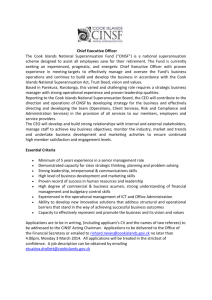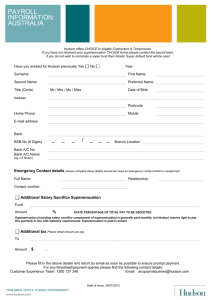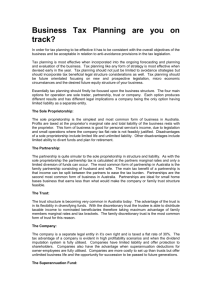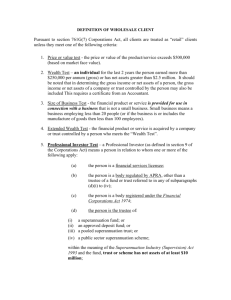7. Assets and Liabilities - Department of Treasury and Finance
advertisement
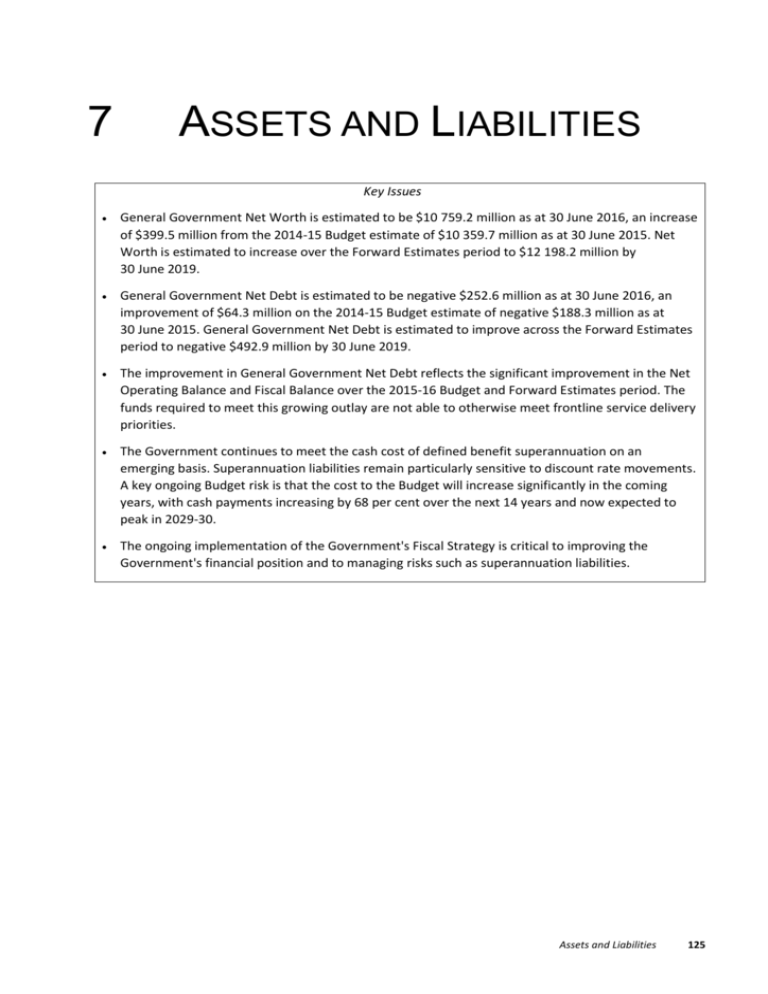
7 ASSETS AND LIABILITIES Key Issues General Government Net Worth is estimated to be $10 759.2 million as at 30 June 2016, an increase of $399.5 million from the 2014-15 Budget estimate of $10 359.7 million as at 30 June 2015. Net Worth is estimated to increase over the Forward Estimates period to $12 198.2 million by 30 June 2019. General Government Net Debt is estimated to be negative $252.6 million as at 30 June 2016, an improvement of $64.3 million on the 2014-15 Budget estimate of negative $188.3 million as at 30 June 2015. General Government Net Debt is estimated to improve across the Forward Estimates period to negative $492.9 million by 30 June 2019. The improvement in General Government Net Debt reflects the significant improvement in the Net Operating Balance and Fiscal Balance over the 2015-16 Budget and Forward Estimates period. The funds required to meet this growing outlay are not able to otherwise meet frontline service delivery priorities. The Government continues to meet the cash cost of defined benefit superannuation on an emerging basis. Superannuation liabilities remain particularly sensitive to discount rate movements. A key ongoing Budget risk is that the cost to the Budget will increase significantly in the coming years, with cash payments increasing by 68 per cent over the next 14 years and now expected to peak in 2029-30. The ongoing implementation of the Government's Fiscal Strategy is critical to improving the Government's financial position and to managing risks such as superannuation liabilities. Assets and Liabilities 125 BALANCE SHEET The Balance Sheet presented in this chapter provides assets and liabilities estimated as at 30 June 2015 to 2019 and reports key indicators for the same period. By providing information on the nature of assets and liabilities held by the Government, this Statement gives an indication of the State's financial strength. The key measures presented in the Balance Sheet are Net Worth, Net Financial Worth, Net Financial Liabilities and Net Debt. Table 7.1 details the estimated General Government Sector Balance Sheet as at 30 June from 2015 to 2019. 126 Assets and Liabilities Table 7.1: General Government Balance Sheet as at 30 June 2015) 2016) 2017) 2018) 2019) Forward) Forward) Forward) Budget) Budget) Estimate) Estimate) Estimate) $m) $m) $m) $m) $m) 1 041.1) 889.3) 698.0) 707.9) 678.1) 77.7) 64.5) 66.4) 68.3) 70.5) 4 331.7) 4 515.0) 4 570.8) 4 626.6) 4 722.3) Assets Financial Assets Cash and Deposits Investments Equity Investment in PNFC and PFC Sectors Other Equity Investments 14.7) 20.0) 20.4) 20.9) 21.2) Receivables 304.3) 331.5) 326.4) 323.2) 320.9) Other Financial Assets 755.2) 661.4) 681.8) 673.5) 679.2) 6 524.8) 6 481.7) 6 363.7) 6 420.2) 6 492.2) Land and Buildings 5 829.6) 5 969.2) 6 281.7) 6 504.1) 6 626.4) Infrastructure 4 634.4) 4 668.9) 4 916.3) 5 115.5) 5 380.1) Plant and Equipment 231.2) 253.5) 243.4) 237.3) 238.0) Heritage and Cultural Assets Non-Financial Assets 485.0) 490.6) 502.8) 515.0) 527.2) Investment Property 11.9) 19.0) 19.2) 19.5) 19.8) Intangibles 35.1) 45.4) 46.4) 44.8) 41.7) Assets Held for Sale 10.9) 7.0) 6.0) 5.1) 4.1) Other Non-Financial Assets Total Assets 36.9) 30.7) 30.5) 28.4) 28.9) 11 274.9) 11 484.2) 12 046.3) 12 469.7) 12 866.2) 17 799.7) 17 965.9) 18 410.0) 18 889.9) 19 358.4) 930.6) 701.3) 550.2) 470.1) 255.7) 5 448.0) 5 470.5) 5 592.1) 5 701.4) 5 795.2) 561.7) 549.9) 567.4) 584.9) 612.1) Liabilities Borrowings Superannuation Employee Entitlements Payables Other Liabilities Total Liabilities NET ASSETS 91.0) 108.4) 109.5) 111.4) 112.0) 408.7) 376.6) 379.2) 381.8) 385.2) 7 439.9) 7 206.7) 7 198.5) 7 249.6) 7 160.2) 10 359.7) 10 759.2) 11 211.5) 11 640.3) 12 198.2) Assets and Liabilities 127 Table 7.1: General Government Balance Sheet as at 30 June (continued) 2015) 2016) 2017) 2018) 2019) Forward) Forward) Forward) Budget) Budget) Estimate) Estimate) Estimate) $m) $m) $m) $m) $m) Accumulated funds 5 434.6) 5 712.1) 5 848.2) 5 974.4) 6 228.0) Asset Revaluation Reserve 4 925.2) 5 047.1) 5 363.4) 5 665.9) 5 970.2) Total Equity 10 359.7) 10 759.2) 11 211.5) 11 640.3) 12 198.2) NET WORTH1 10 359.7) 10 759.2) 11 211.5) 11 640.3) 12 198.2) (915.1) (725.0) (834.8) (829.3) (668.0) 5 246.8) 5 240.0) 5 405.5) 5 455.9) 5 390.3) (188.3) (252.6) (214.2) (306.0) (492.9) Equity NET FINANCIAL WORTH2 NET FINANCIAL LIABILITIES3 NET DEBT4 Notes: 1. Net Worth represents Total Assets less Total Liabilities. 2. Net Financial Worth represents Financial Assets less Total Liabilities. Net Financial Worth is estimated to be negative $725 million as at 30 June 2016, an improvement of $190.1 million from the 2014-15 Budget estimate of negative $915.1 million as at 30 June 2015. 3. Net Financial Liabilities represents total liabilities less financial assets, excluding equity investments in government businesses. 4. Net Debt represents Borrowings less the sum of Cash and Deposits and Investments. ASSETS Total Assets are estimated to be $17 965.9 million as at 30 June 2016, an increase of $166.2 million from the 2014-15 Budget estimate of $17 799.7 million as at 30 June 2015. The increase primarily reflects an increase in Land and Buildings; Infrastructure; Plant and Equipment; Equity Investment in PNFC and PFC Sectors and Receivables partly offset by a decrease in Cash and Deposits and Other Financial Assets. Total assets are estimated to increase across the Forward Estimates period from $17 965.9 million as at 30 June 2016 to $19 358.4 million as at 30 June 2019. Equity Investment in PNFC and PFC Sectors This item consists of the Government's investment in the net assets of the Public Non‑Financial Corporations (PNFC) and Public Financial Corporations (PFC) sectors. The Government's equity investment is estimated to be $4 515 million as at 30 June 2016, an increase of $183.3 million from the 2014-15 Budget estimate of $4 331.7 million as at 30 June 2015. The increase primarily reflects an increase in Net Assets for Hydro Tasmania, Motor Accidents Insurance Board, Tasmanian Irrigation Pty Ltd, and Tasmanian Ports Corporation Pty Ltd. Chart 7.1 illustrates the components of the Government's Equity Investment holdings. 128 Assets and Liabilities Chart 7.1: Equity Investment in PNFC and PFC Sectors as at 30 June 2016 Transport $438.0m (9.7%) Other $116.6m (2.6%) Financial $463.0m (10.2%) Resource Management $149.7m (3.3%) Ports $187.7m (4.2%) Electricity $3 160.2m (70.0%) Other Financial Assets Other Financial Assets include Income Tax Equivalents Receivable, Prepayments and Other Financial Assets. Other Financial Assets is estimated to be $661.4 million as at 30 June 2016, a decrease of $93.8 million on the 2014-15 Budget estimate of $755.2 million as at 30 June 2015. The decrease primarily reflects revised income tax equivalent estimates and a more accurate estimate based on actual 2014 balances. Table 7.2 provides a summary of Other Financial Assets. Assets and Liabilities 129 Table 7.2: Other Financial Assets as at 30 June Income Tax Equivalents Receivable1 Prepayments Other Financial Assets Total 2015) 2016) 2017) 2018) 2019) Forward) Forward) Forward) Budget) Budget) Estimate) Estimate) Estimate) $m) $m) $m) $m) $m) 731.7) 639.2) 659.3) 650.9) 656.3) 21.9) 21.1) 21.3) 21.5) 21.7) 1.7) 1.2) 1.2) 1.2) 1.2) 755.2) 661.4) 681.8) 673.5) 679.2) Note 1. Income Tax Equivalents Receivable is an asset held by the General Government Sector that mirrors the Income Tax Liabilities held by Government Business Enterprises and State-owned Companies within the PNFC and PFC sectors. The receivable reflects timing differences in the payment of income tax equivalents in accordance with Australian Accounting Standards. The decrease in Income Tax Equivalents Receivable reflects revised tax estimates. Non-Financial Assets Non-Financial Assets include the value of Crown Land and other land holdings, including national parks and conservation areas, schools, hospitals and other buildings held by the Government for the provision of goods and services. Non-Financial Assets also includes Intangibles, Assets Held for Sale and Other Non-Financial Assets. Land and Buildings is estimated to be $5 969.2 million as at 30 June 2016, an increase of $139.6 million on the 2014-15 Budget estimate of $5 829.6 million as at 30 June 2015. Infrastructure is estimated to be $4 668.9 million as at 30 June 2016, an increase of $34.5 million on the 2014-15 Budget estimate of $4 634.4 million as at 30 June 2015. The increase in Land and Buildings and Infrastructure over the 2015-16 Budget and Forward Estimates period partly reflects the implementation of the Government's $1.8 billion infrastructure investment program. Further information regarding Infrastructure Investment is provided in chapter 6 of this Budget Paper. LIABILITIES Total Liabilities is estimated to be $7 206.7 million as at 30 June 2016 and remains relatively stable across the Forward Estimates period with estimated Total Liabilities of $7 160.2 million as at 30 June 2019. The estimated Borrowings of $701.3 million as at 30 June 2016 includes an estimated end of year borrowing of $477.8 million to be undertaken on 30 June 2016. The end of year borrowing has no impact on the Government's Net Debt as the same amount will be borrowed and invested overnight on 30 June with the Tasmanian Public Finance Corporation, grossing up the amount of cash held and borrowings. Borrowings in 2015-16 and the Forward Estimates period are lower compared to those published in the 2014-15 Budget. This reduction is primarily due to an improved Consolidated Fund position in all years. Payables is estimated to be $108.4 million as at 30 June 2016, an increase of $17.4 million, on the 2014-15 Budget estimate of $91 million. The increase primarily reflects a more accurate estimate, after 130 Assets and Liabilities taking into account the 2014 actual balances that were not known at the time of preparing the 2014-15 Budget. Other Liabilities is estimated to be $376.6 million as at 30 June 2016, a decrease of $32.1 million compared to the 2014-15 Budget of $408.7 million as at 30 June 2015. The decrease primarily reflects a more accurate estimate, after taking into account 2014 actual balances that were not known at the time of preparing the 2014-15 Budget and a revised actuary estimate for the Tasmanian Risk Management Fund liabilities. General Government Superannuation Liability The Government's superannuation liability is an estimate of the obligations of the State with respect to liabilities arising from the current and former members of unfunded or partially funded Public Sector defined benefit superannuation schemes, which were closed to new members with effect from May 1999. The superannuation liability is an estimate of the Net Present Value of the Government's share of meeting current and future benefit payments for scheme members. The superannuation liability differs from many other financial liabilities, such as Borrowings, which can be called on for repayment in full at any point in time. The superannuation liability has arisen over many decades because benefits have been funded on an emerging basis when scheme members become entitled to a pension or lump sum benefit. That is, the Government's portion of the final benefit is paid when it falls due, with the remaining part of the benefit being funded from the scheme's assets. The major schemes currently operating in the General Government Sector that have an unfunded liability are those established under the Retirement Benefits Act 1993, the former Parliamentary Superannuation Act 1973, the former Parliamentary Retiring Benefits Act 1985 and the Judges' Contributory Pensions Act 1968. While these schemes have been closed to new members, because of the long-term nature of superannuation benefits, the superannuation liability continues to grow as existing members accrue additional years of service as they approach retirement age. The liability is projected to grow until 2022-23 and then, as the 'baby boomer' generation reaches retirement age (the current average age is 52), gradually decline over the following five or six decades. The estimated General Government Superannuation Liability as at 30 June 2016 is $5 470.5 million, which is comprised of the estimated present value of the liability of $7 147.4 million less the estimated fair value of plan assets of $1 676.9 million. Assets and Liabilities 131 Table 7.3: General Government Superannuation Liability as at 2016) 2017) Forward) Forward) Forward) ) Budget) Estimate) Estimate) Estimate) $m) $m) $m) $m) 7 147.4 7 263.5 7 363.2 7 443.2 (1 676.9) (1 671.5) (1 661.8) (1 648.0) 5 470.5 5 592.1 5 701.4 5 795.2 Present Value of Superannuation Liability Fair Value of Plan Assets 30 June Total 2018) 2019) Chart 7.2 projects the General Government Superannuation Liability (net of plan assets) over the total life of the defined benefit schemes. Chart 7.2: General Government Superannuation Liability Projection, 30 June 2016 to 30 June 2083 7 000 6 000 $ million 5 000 4 000 3 000 2 000 1 000 Superannuation Liability 132 Assets and Liabilities Jun-2081 Jun-2076 Jun-2071 Jun-2066 Jun-2061 Jun-2056 Jun-2051 Jun-2046 Jun-2041 Jun-2036 Jun-2031 Jun-2026 Jun-2021 Jun-2016 0 Independent actuarial assessments are prepared by the State Actuary to provide reporting and disclosure information, relating to the General Government Superannuation Liability, in respect of current and former employees who have defined benefits arising from membership of the closed defined benefit superannuation schemes. The actuarial assumptions used are the State Actuary's best estimates of the variables that will determine the ultimate cost of providing long-term superannuation benefits. Actuarial assumptions must be unbiased (i.e. neither imprudent nor excessively conservative) and should reflect the economic relationships between factors such as inflation, rates of salary increase, the return on scheme assets and discount rates. Key assumptions recommended and used by the State Actuary in preparing the most recent actuarial estimate of the General Government Superannuation Liability are: Discount Rate - 5.5 per cent; Salary Increase Rate - 3.0 per cent; Pension Increase Rate - 2.5 per cent; and Investment Earnings - 5.5 per cent. It is important to recognise that the actuarial estimate prepared by the State Actuary is a snapshot of a scheme's estimated financial position at a particular point in time, and that the actuarial results do not predict a scheme's future financial position or its ability to pay benefits in the future. Over time, a scheme's total cost will depend on a number of factors, including the amount of benefits the scheme pays, the number of people paid benefits, scheme expenses and the amount earned on any assets invested to pay the benefits. These amounts and others are uncertain at the valuation date and are estimated by the State Actuary. The Superannuation Liability is particularly sensitive to discount rate movements. Since 2009-10, due to the volatility of the bond market and the long-term nature of the liability, the Budget projections of the Superannuation Liability do not use the current Australian Government long-term bond rate. The 2015-16 Budget projections are based on an average discount rate of 5.5 per cent. There is a strong inverse relationship between the discount rate and the valuation of the liability. Chart 7.3 shows the impact of an increase or decrease of one per cent in the average discount rate used to value the General Government Superannuation Liability. The base rate column represents the estimated Present Value of the Superannuation Liability (Gross) as at 30 June in each year valued by the State Actuary using a discount rate of 5.5 per cent. Assets and Liabilities 133 Chart 7.3: Sensitivity Analysis of the General Government Superannuation Liability as at 30 June Currently, the emerging cash cost of defined benefit superannuation payments is met from the Consolidated Fund, funded partly by agency contributions and by a Reserved by Law contribution, which comprises the balance of the Government's share of pension and lump sum benefit costs. Chart 7.4 shows the estimated employer contribution payments, made up of both pension and lump sum benefit costs, over the total life of the defined benefit schemes. Chart 7.4: Defined Benefit Superannuation Costs, 2015-16 to 2082-83 500 450 400 $ million 350 300 250 200 150 100 50 2080-81 2075-76 2070-71 2065-66 2060-61 2055-56 2050-51 2045-46 2040-41 2035-36 2030-31 2025-26 2020-21 2015-16 0 Lump Sum and Pension Payments A key budget risk is that the cost to the Budget will increase significantly in coming years, increasing by 68 per cent (83 per cent in the 2014-15 Budget) over the next 14 years and peaking in 2029-30, rather than 134 Assets and Liabilities 2030-31 as was projected in the 2014-15 Budget. The estimated cost to the Budget is based on the most recent actuarial estimates. The change from the projections in the 2014-15 Budget (a 15 percentage point reduction in the cost in 14 years and a one year forward movement in the expected peak) reflects a greater number of defined benefit member exits during 2014-15, than was projected in the 2014-15 Budget. In 2015-16, defined benefit superannuation costs are estimated to be 4.7 per cent of Cash Receipts from Operating Activities in the General Government Sector. Defined benefit superannuation costs, as a percentage of General Government cash receipts, is estimated to increase to 5.2 per cent within five years (by 2020-21) and 5.3 per cent in 10 years (2025-26). Defined benefit superannuation costs as a percentage of General Government cash receipts is estimated to peak at 5.4 per cent in 2023-24, and then is estimated to decrease to 4.5 per cent in 15 years (2030-31) and to 3.5 per cent in 20 years (2035-36). While movements in discount rates have a significant impact on the valuation of the Superannuation Liability at any point of time, those discount rate movements do not impact on the nominal cash flows required to meet the emerging cost of benefits paid to members. Table 7.4 shows the estimated nominal cash flows required to meet the emerging cost of superannuation benefits payable to members. This represents the estimated total cost of benefits payable and includes the General Government share, together with the share of benefits that are funded from scheme assets. Table 7.4: Undiscounted General Government Defined Benefit Obligations 2015 Estimate $m Estimated total benefit payments to be made in the period No later than 1 year 375 Later than 1 year and no later than 2 years 393 Later than 2 years and no later than 5 years 1 270 Later than 5 years and no later than 10 years 2 436 Later than 10 years and no later than 15 years 2 707 Later than 15 years and no later than 20 years 2 742 Later than 20 years and no later than 25 years 2 635 Later than 25 years and no later than 30 years 2 374 Later than 30 years and no later than 35 years 2 000 Later than 35 years and no later than 40 years 1 546 Later than 40 years and no later than 45 years 1 052 Later than 45 years and no later than 50 years 604 Undiscounted defined benefit obligation 20 134 After 50 years there is expected to be a reducing level of cash for a further 25 years totalling approximately: 382 Assets and Liabilities 135 Total State Superannuation Liability The estimated Total State Superannuation Liability as at 30 June 2016 is $6 042.1 million, which is comprised of the estimated present value of the liability of $7 887.1 million less the estimated fair value of plan assets of $1 845.0 million. Total State includes Government Business Enterprises and State-owned Companies. Table 7.5: Total State Superannuation Liability as at 30 June 2016) Present Value of Superannuation Liability Fair Value of Plan Assets Total 2017) 2018) 2019) Forward) Forward) Forward) ) Budget) Estimate) Estimate) Estimate) $m) $m) $m) $m) 7 887.1 8 015.9 8 126.4 8 215.0 (1 845.0) (1 839.2) (1 828.7) (1 813.5) 6 042.1 6 176.6 6 297.7 6 401.5 Chart 7.5 shows the impact of an increase or decrease of one per cent in the discount rate used to value the Total State Superannuation Liability. The base rate column represents the estimated Present Value of the Superannuation Liability (Gross) as at 30 June in each year valued by the State Actuary using a discount rate of 5.5 per cent. Chart 7.5: 136 Sensitivity Analysis of the Total State Superannuation Liability as at 30 June Assets and Liabilities Table 7.6 shows the estimated nominal cash flows required to meet the emerging cost of superannuation benefits payable to members. This represents the estimated total cost of benefits payable and includes the Total State share, together with the share of benefits that are funded from scheme assets. Table 7.6: Undiscounted Total State Defined Benefit Obligations 2015 Estimate $m Estimated total benefit payments to be made in the period No later than 1 year 413 Later than 1 year and no later than 2 years 433 Later than 2 years and no later than 5 years 1 401 Later than 5 years and no later than 10 years 2 687 Later than 10 years and no later than 15 years 2 987 Later than 15 years and no later than 20 years 3 026 Later than 20 years and no later than 25 years 2 908 Later than 25 years and no later than 30 years 2 622 Later than 30 years and no later than 35 years 2 210 Later than 35 years and no later than 40 years 1 709 Later than 40 years and no later than 45 years 1 163 Later than 45 years and no later than 50 years 668 Undiscounted defined benefit obligation 22 225 After 50 years there is expected to be a reducing level of cash for a further 25 years totalling approximately: 422 Assets and Liabilities 137 TASMANIAN RISK MANAGEMENT FUND Purpose of the Fund The Tasmanian Risk Management Fund was established on 1 January 1999 to provide a whole-of-government approach to funding and managing the insurable liabilities of inner-Budget agencies. Agencies are covered for the majority of insurable risks to which they are exposed or for which they choose to accept responsibility and the Fund agrees to cover, including: personal injury (including workers' compensation and personal accident); property (including buildings and contents, business interruption, motor vehicles, machinery, marine hull, transit and fraud); liability (including public and products, professional and directors' and officers' liability); medical liability; and travel. All classes are self-insured by the Fund except for marine hull and travel, which remain insured through the private sector, as this is more cost-effective than self-insurance for these two categories of risk. From 1 July 2015 it is anticipated that catastrophe cover will also be placed through an external insurance provider. Performance of the Fund The Fund operates on a cost recovery basis with all inner-Budget agencies making contributions each year in order to build up reserves to meet current and emerging costs. Contributions are based on advice from an independent actuary and are adjusted over time according to the claims experience of agencies. There is expected to be an overall decrease in contributions for 2015-16 mainly due to reductions in both workers' compensation and general property contributions. The decrease in workers' compensation contributions is primarily as a result of an assumed lower number and cost of claims for 2015-16. The significant reduction in the general property contributions reflects favourable claims experience in this risk area and the large claims provision target being exceeded. Contributions for general liability and motor vehicles have also decreased moderately. These decreases have been offset to a large extent by a substantial increase in medical liability contributions following a reduction in the discount rate and an adjustment to the claim cost methodology. Overall, total agency contributions are expected to decrease from $55.0 million in 2014-15 to $54.0 million in 2015-16. It is noted that these contributions do not include the cost of purchasing external property insurance for catastrophe cover which is expected to be placed from 1 July 2015. The Fund's Actuary takes into account the level of assets and liabilities in each risk category when determining annual contributions. As the aim is to match assets and liabilities over time, any surpluses will continue to be taken into account by the Fund's actuary at the time agency contributions are determined. 138 Assets and Liabilities Table 7.7: Financial Position of the Tasmanian Risk Management Fund as at 30 June 2015 2016 Estimated 2017 2018 2019 Forward Forward Forward Outcome Budget Estimate Estimate Estimate $m) $m) $m) $m) $m) 218.5 221.9 226.7 231.8 237.1 Current Assets Carried Forward Cash Equivalent Balance1 Receivables 1.2 1.2 1.2 1.2 1.2 219.7 223.1 227.9 233.0 238.3 82.3 85.6 88.8 91.9 95.0 Property 5.9 2.8 2.9 3.0 3.1 Motor Vehicle 0.3 0.3 0.3 0.3 0.3 Liability 9.0 9.3 9.5 9.8 10.0 Medical 109.9 113.9 118.1 122.0 126.8 Liabilities2 Personal Injury Payables Net Assets 1.2 1.2 1.2 1.2 1.2 208.6 213.1 220.8 228.2 236.4 11.1 10.0 7.1 4.8 1.9 Notes: 1. Includes the estimated balance from the previous year with adjustments for expected return on investments, with return rates set to ensure the long-term matching of increases in liabilities as provided by the Fund's actuary. 2. Liabilities are calculated by the Fund's actuary as at 31 December 2014. Assets and Liabilities 139

